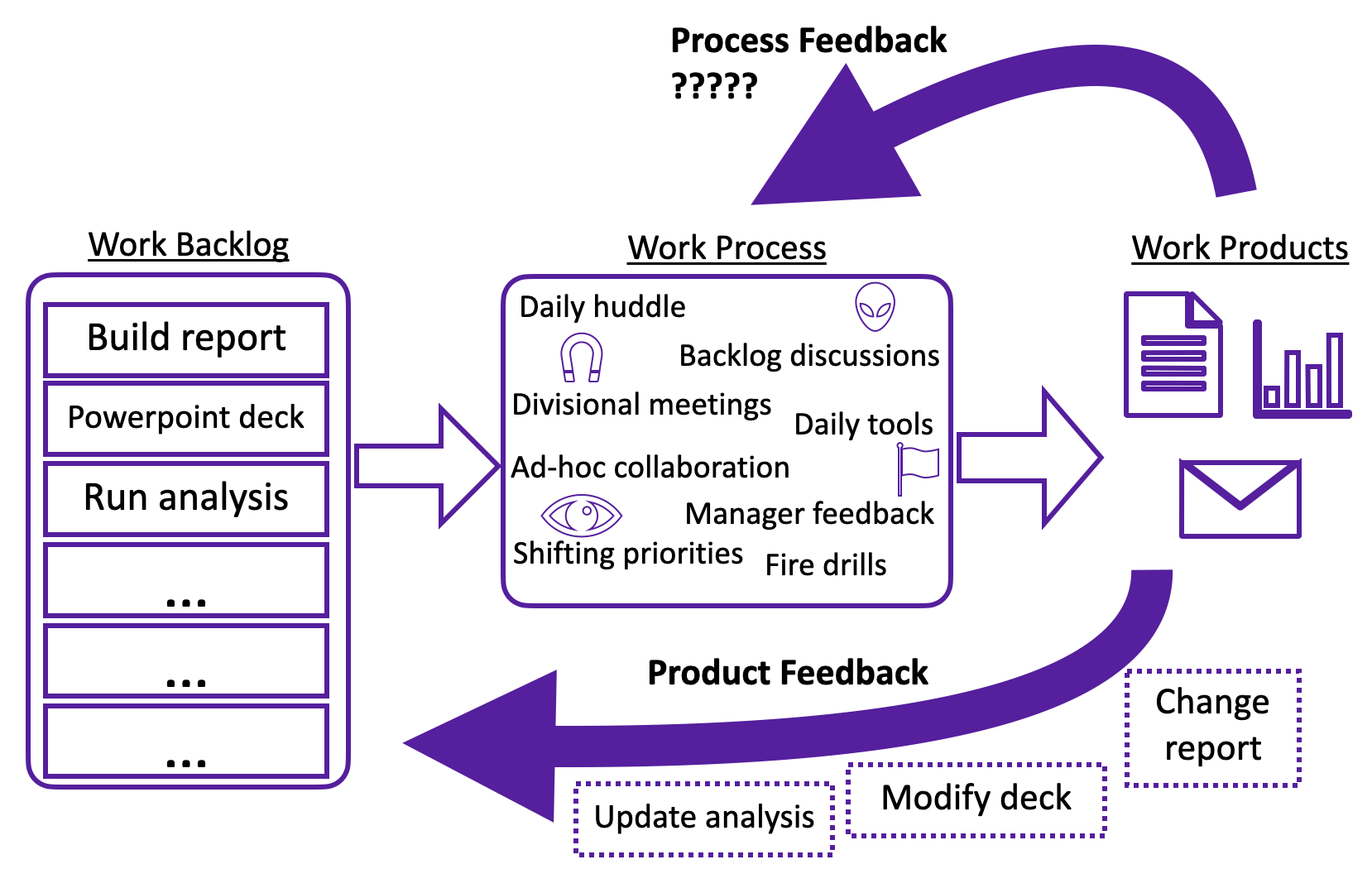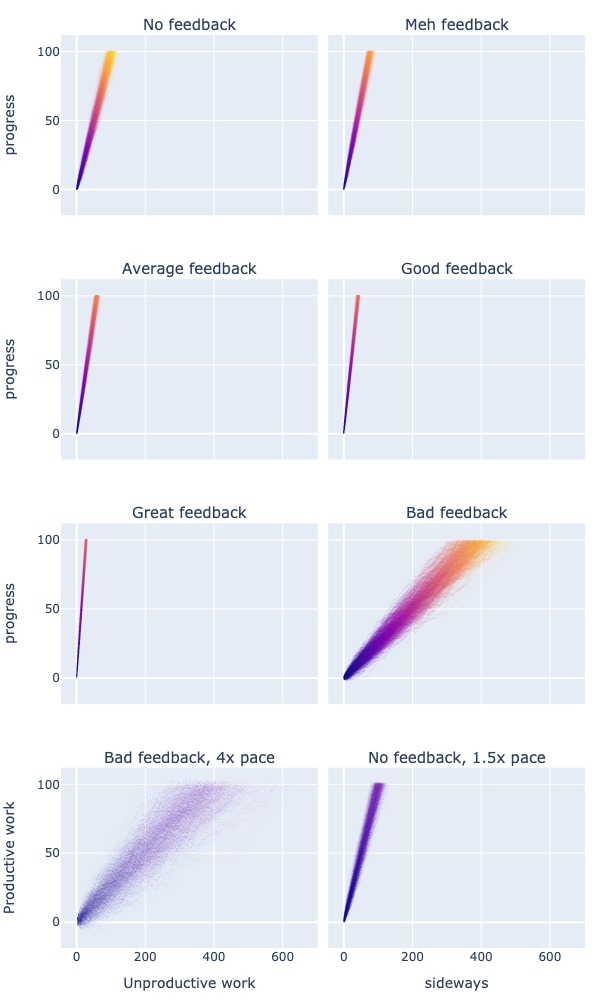Get your feed off my back!
This post discusses the never-before-discussed topic of feedback! Including an often-forgoteen feedback loop, a mathematical proof that feedback is good, and my tips for feedback. Enjoy!
The forgotten feedback loop
Many work environments generally function in the following fashion:
- Work is ingested in to a team’s backlog and prioritized against all the other things going on, usually by leadership
- People are assigned items to work on, or people pull items that are at the top of the backlog when they have bandwidth
- Various ‘ways of working’ things happen: team meetings, daily check-ins, broader-team meetings, 1-on-1s with the leaders, interact informally with one another, help each other with little issues, etc.
- The team creates work products: reports, meetings, emails, analysis, content, etc.
- The customers of the work products provide specific feedback on the work products. That feedback either gets handled immediately (change this slide…done), or gets re-ingested into the team’s backlog and re-prioritized
- Repeat until retirement (feel free to go start your own company if this makes you unhappy)

Consumers of your team’s work usually can provide solid, tangible, understandable feedback. This report is wrong. This dashboard is too small. The excel sheet needs these changes. Boom, I can go work on that, I understand it, etc.
The catch: that work product feedback will be processed through the same work process that produced the initial work product. Something seem wrong?
Feedback on how the team delivers work is often forgotten, whereas feedback on the work a team delivers is readily available.
Oh yeah…no one took the time to provide feedback on how the team is delivering their work, aka their work process. This massive input to team work quality/pace never receives dedicated time for a few reasons:
- There’s no report to critique, no powerpoint deck to slander, no tangible item to discuss; conversations about the intangible are mentally draining
- Talking about how you produce the work you produce sometimes feels very meta and abstract
- It is hard to specifically articulate what the team’s work process is in order to improve/critique it
- Team members have probably been burned in the past by having their suggestions be praised-then-disregarded (”we should try X” → ”wow great idea” → trash)
- Team members are not confident enough/secure enough to share what they want with their team; they do not want to impose their preferences on others
Regardless of the challenge, it is imperative to collect feedback on the work process.
The definition of insanity is doing the same thing over and over and expecting a different result - Michael Scott
Odds are your team has had at least one person turn over just in the last 6 months. When that happens, team composition changes, and the ideal way of working also changes. Implementing a work process feedback loop enables you to catch the team’s changing composition and adapt the team’s process to the new group.
Will every bit of feedback be productive and useful and meaningful? No. True story: as an Agile Coach one of the teams I coached has their sprint retrospective and the feedback that got the most traction was, “I don’t want to toss the nerf ball to signify who is talking”…
All you can do is turn on the feedback loop and set the team up to mold their work process to their specific way of working.
Good feedback: 50% productivity boost
We are going to go through a hypothetical to prove (or disprove) that feedback can be a productivity boost.
Let’s say your team’s objective is to produce a 100-unit ‘widget’, and your team works at 1 unit per day; the widget requires a minimum of 100 days of work for a perfect team.
However, your work may not directly drive towards the desired end state. There are many inefficiencies that can cause a team to produce work that is not perfectly aligned with the desired direction:
- Inefficiency in vision: the customer does not actually know what they want
- Inefficiency in communication: there is a breakdown somewhere between the message the customer wants to communicate, the words they say, the words you year, and what you interpret the message as
- Inefficiency in delivery: the actual execution of work deviates from what should be created
Restated: a perfectly efficient team will take 100 days, but your team may take 130 days. A different team may take 200 days. What contributes to the difference?
Team work throughput is definitely a major factor: if a team can produce 2 units per day, that is obviously better. Another important factor is output direction, or how aligned your teams output is with the desired direction. And the major contributor to direction: early and often feedback. Providing/receiving feedback limits the percent of work that is unproductive; if you understand the vision and changes, you’re better able to produce work aligned with that vision.

A mathematical model of this scenario assumes that your teams output can be somewhere between perfectly productive (100% in direction of widget) and perfectly unproductive (100% sideways), or even some small percent counterproductive (backwards). In our simulation, we will test 6 levels of feedback, with each level producing different amounts of productive output depending on how good the feedback is.
| Feedback Quality | Range of Angles | Percent Productive |
|---|---|---|
| None | 0 to 90 | 0% to 100% |
| Meh | 15 to 90 | 26% to 100% |
| Average | 30 to 90 | 50% to 100% |
| Good | 45 to 90 | 71% to 100% |
| Great | 60 to 90 | 87% to 100% |
| Bad | -30 to 60 | -50% to 87% |
I ran 500 simulations for each feedback quality, with each simulation representing a team’s journey to produce the 100-unit widget. The team randomly samples a productive percent each day, and continues until they reach the goal of producing 100 units of productive work. The results are quite interesting.
| Feedback Quality | Percent Productive | Average days to complete |
|---|---|---|
| Great | 87% to 100% | 105 days |
| None, 1.5x throughput | 0% to 100% | 106 days |
| Good | 71% to 100% | 112 days |
| Bad, 4x throughput | -50% to 87% | 112 days |
| Average | 50% to 100% | 122 days |
| Meh | 26% to 100% | 137 days |
| None | 0% to 100% | 159 days |
| Bad | -50% to 87% | 446 days |

- Shocker of the century: channeling more of a team’s work into a productive direction makes that team produce the correct output quicker. Like and subscribe to my blog for more ground breaking analysis!
- It is surprising how much throughput is required to compensate for poor feedback: Counterproductive/bad feedback slows the team by ~4.5x, so 4x throughput is needed to deliver the correct output in the same time as a normally-paced team with good feedback (112 days)
- Which is easier: increasing throughput by 50% or giving/receiving good product feedback? Because 1.5x throughput is roughly equal to great feedback (105 days)
The obvious caveats aside, it’s clear to see that good feedback can produce more productive teams. How do you give that good feedback?
Ryan’s keys to feedback
Last year I took 7 leadership courses…so you could say I’m pretty well versed in the bulleted list of ‘how to give good feedback’. The list below is from my own experience, not a leadership course, so I think it’s the best one out there.
- Time-sensitive: If I use a lot of filler words, tell me that day, ideally shortly after the presentation. Otherwise, the moment is lost.
- Correct mindset and context: The feedback receiver must be ready to receive feedback (try saying that 5 times fast). This means they must be in the proper mindset, open to receiving feedback (not everyone is at all times), and in the proper environment.
- Generalizable with specific examples: Patterns make the world go round; they allow us to handle unexpected/unforeseen. When giving feedback, tie it to a generalizable pattern and give the specific examples that violated that pattern. This helps the receiver connect the specific feedback to new future scenarios.
- Example: A slide deck has too many colors
- Pattern: simplicity helps people understand things
- Examples: slide 4, 5, 6 used 10 different colors, which distracted from the overall message
- Example: A slide deck has too many colors
One last point: when soliciting feedback you must act upon it or never receive feedback again. Consider the following scenario:
- A coworker or leader says “I’m always open to feedback, stop by whenever, open door, drop on in, pals…”
- You think the team would function better if a change was made to how the team schedules work, so you stop by their office and share that with them
- Since you provided the feedback in a time-sensitive fashion, in the correct context, and with specific examples that are also generalizable, they received the message 100% (great job!)
- Nothing happens.
You are not going to suggest anything to that person again. The lesson: feedback solicitation without action leaves a bad taste in mouths and shuts down any future feedback. A lose-lose.
